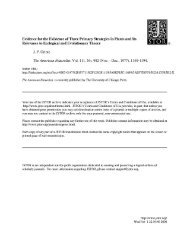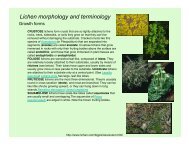Arctic Ecosystems in Russia - Alaska Geobotany Center
Arctic Ecosystems in Russia - Alaska Geobotany Center
Arctic Ecosystems in Russia - Alaska Geobotany Center
You also want an ePaper? Increase the reach of your titles
YUMPU automatically turns print PDFs into web optimized ePapers that Google loves.
ARCTIC ECOSYSTEMS IN RUSSIA<br />
Fig. 16.43. Irregular mosaic structural type <strong>in</strong> a Dicranum elongatum-Betula nana-Carex ensifolia ssp. arctisibirica hummocky<br />
community <strong>in</strong> the southern tundra subzone at Kresty, Taymyr. Vegetation on hummocks (1-5): 1, Ptilidium ciliare + Dicranum spp.<br />
+ Aulacomnium turgidum + Vacc<strong>in</strong>ium vitis-idaea ssp. m<strong>in</strong>us + Cassiope tetragona + Dryas punclata; 2, Ptilidium ciliare + Dicranum<br />
spp. + Aulacomnium turgidum + Betula nana + Salix reptans; 3, Ptilidium ciliare + Dicranum spp. + Aulacomnium turgidum + Vacc<strong>in</strong>ium<br />
vitis-idaea ssp. m<strong>in</strong>us + V. ulig<strong>in</strong>osum ssp. microphyllum + Ledum decumbens + Betula nana; 4, Aulacomnium turgidum + Dicranum spp.<br />
+ Ptilidium ciliare + Vacc<strong>in</strong>ium ulig<strong>in</strong>osum spp. microphyllum + Ledum decumbens + Betula nana + Carex ensifolia ssp. arctisibirica;<br />
5, Dicranum elongatum + Sphenolobus m<strong>in</strong>utus + Tritomaria qu<strong>in</strong>quedentata. Vegetation <strong>in</strong> troughs (6-10): 6, Tomenthypnum nitens +<br />
Aulacomnium turgidum + Carex ensifolia ssp. arctisibirica; 1, Aulacomnium turgidum + Dicranum spp. + Betula nana; 8, Ptilidium ciliare<br />
+ Dicranum spp. + Aulacomnium turgidum + Vacc<strong>in</strong>ium ulig<strong>in</strong>osum ssp. microphyllum + Ledum decumbens + Cassiope tetragona;<br />
9, Ptilidium ciliare + Aulacomnium turgidum + Dicranum spp. + Carex ensifolia ssp. arctisibirica + Betula nana + Salix reptans;<br />
10, Tomenthypnum nitens + Ptilidium ciliare.<br />
<strong>in</strong>g. Thus, the elements of nodal structure are<br />
comb<strong>in</strong>ed with irregular mosaics (various communities<br />
with mosaics of mosses, dwarf-shrubs,<br />
and solitary tall shrubs or tussock communities of<br />
Eriophorum vag<strong>in</strong>atum) or with the sporadically<br />
spotted type <strong>in</strong> meadows on southern slopes. Regular<br />
cyclic and irregular mosaic types with nodal<br />
elements are characteristic of tundra communities<br />
proper which are most advanced <strong>in</strong> the succession<br />
and most stable. Homogeneous and sporadically<br />
spotted types are characteristic of "<strong>in</strong>trazonal"<br />
communities, ma<strong>in</strong>ly at early successional stages.<br />
The elements of homogeneous, sporadically<br />
spotted, irregular mosaic, and nodal types are<br />
415<br />
formed by <strong>in</strong>dividuals (heterogeneity of the first<br />
order). The regular cyclic type on the other hand<br />
shows a heterogeneity of the second order, with<br />
elements consist<strong>in</strong>g of s<strong>in</strong>usia or microcommunities.<br />
Mosaics of the cover of "zonal" communities on<br />
"plakor" cause problems <strong>in</strong> determ<strong>in</strong>ation of homogeneous<br />
plots which could serve as the smallest<br />
units for the purpose of classification <strong>in</strong> order to<br />
establish syntaxa. In the <strong>Russia</strong>n tundra literature,<br />
sites with a regular cyclic structure of vegetation<br />
cover are sometimes considered as complexes of<br />
phytocenoses (Nor<strong>in</strong>, 1979) and their elements as<br />
phytocenoses. About 25 years of research <strong>in</strong> the




